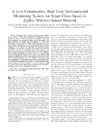Identificador persistente para citar o vincular este elemento:
https://accedacris.ulpgc.es/handle/10553/15312
| Title: | A low consumption real time environmental monitoring system for smart cities based on ZigBee wireless sensor network | Authors: | Sánchez-Rodríguez, David Sánchez-Rosario, Francisco Alonso-Hernández, Jesús B. Travieso-González, Carlos M. Alonso-González, Itziar G. Ley-Bosch, Carlos Ramirez-Casañas, Carlos M. Quintana-Suárez, Miguel A. |
UNESCO Clasification: | 3325 Tecnología de las telecomunicaciones | Keywords: | Wireless Sensor Networks ZigBee Environmental Monitoring Smart Cities |
Issue Date: | 2015 | Publisher: | Institute of Electrical and Electronics Engineers (IEEE) | Journal: | International Wireless Communications and Mobile Computing Conference | Conference: | 11th International Wireless Communications and Mobile Computing Conference, IWCMC 2015 | Abstract: | Nowadays, there is an increasing interest in wireless sensor networks (WSN) for environmental monitoring systems because it can be used to improve the quality of life and living conditions are becoming a major concern to people. This paper describes the design and development of a real time monitoring system based on ZigBee WSN characterized by a lower energy consumption, low cost, reduced dimensions and fast adaptation to the network tree topology. The developed system encompasses an optimized sensing process about environmental parameters, low rate transmission from sensor nodes to the gateway, packet parsing and data storing in a remote database and real time visualization through a web server. A monitoring system integrating the outlined system has been deployed and tested for monitoring the level of dust particles in the air, acoustic levels in different places of a city, ambient temperature and relative humidity. A calibration process of a low cost audio sensor was performed to measure the acoustic level from different noise sources, hence, it is not necessary to use an expensive sound level meter at each node. Furthermore, experimental results show autonomy nodes can be about three months. | URI: | https://accedacris.ulpgc.es/handle/10553/15312 | ISBN: | 978-1-4799-5343-1 | ISSN: | 2376-6492 | DOI: | 10.1109/IWCMC.2015.7289169 | Source: | IWCMC 2015 - 11th International Wireless Communications and Mobile Computing Conference [EISSN 2376-6492 ], p. 702-707, (Octubre 2015) |
| Appears in Collections: | Actas de congresos |
SCOPUSTM
Citations
18
checked on Jun 8, 2025
WEB OF SCIENCETM
Citations
10
checked on Feb 25, 2024
Page view(s)
79
checked on Sep 16, 2023
Download(s)
204
checked on Sep 16, 2023
Google ScholarTM
Check
Altmetric
Share
Export metadata
This item is licensed under a Creative Commons License

